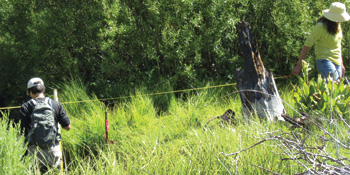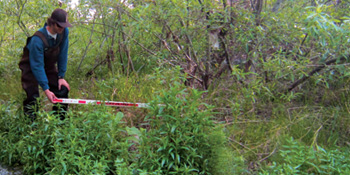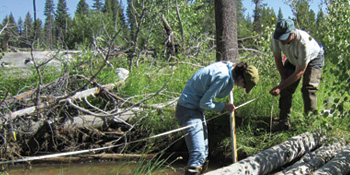
CRAM is a cost-effective and scientifically defensible rapid assessment method for monitoring the conditions of streams and wetlands throughout California. It is designed for assessing ambient conditions within watersheds, regions, and throughout the State. It can also be used to assess the performance of compensatory mitigation projects and restoration projects.
What is Rapid? CRAM requires a team of 2-3 trained practitioners less than 3 hours to assess a representative wetland area.
CRAM Module Development
The overall process for CRAM module development includes several steps:
- a definition phase;
- a basic design phase;
- a verification phase; and
- a validation phase.
This approach and procedure has been approved by the California Water Quality Monitoring Council and subject to the peer review process of the California State Water Resources Control Board and California Environmental Protection Agency. The table below lists the current status of development for each CRAM module.
Because new modules may be developed by different teams through different funding sources, it is important that each new module of CRAM be developed with oversight and guidance provided by the statewide Level 2 Committee of the California Wetland Monitoring Workgroup (CWMW), which is charged with the oversight of Level 2 assessments, including CRAM. The CWMW functions as a subcommittee of the California Water Quality Monitoring Council.
| Estuarine-Perennial | Estuarine-BarBuilt | Riverine | Riverine-Episodic | Riverine-Tidal | Depressional | Vernal Pool (Individual and Systems) | Slope | Lacustrine | Playa | |
|---|---|---|---|---|---|---|---|---|---|---|
| Phase 1: Definition Provide evidence to L2 Committee of the need for a new module, form statewide development team, develop definition of wetland type that is the focus of the effort | X | X | X | X | X | X | X | X | X | X |
| Phase 2: Basic Design Develop a conceptual model of the natural processes and anthropogenic stressors that control the form, structure, and function of the proposed wetland class, develop the "Verification version" of the module, Identify the physical "Test Gradient" on which to test the module | X | X | X | X | X | X | X | X | minimal progress | minimal progress |
| Phase 3: Test Verification Version Test the efficacy of the verification version of the module by selecting 30+ Test Sites along Test Gradient, look for strongly biased scores in each metric, revise metrics as needed, report results to the L2 Committee, decide if more verification work is needed. Present final results to CWMW. | X | X | X | X | in process | X | X | X | ||
| Phase 4: Validation Validate the completed verification version of the module by identifying existing and/or preferred Level 3 data on which to regress newly collected L2 data. Analyze the validation data by comparing the actual results of the correlation between L2 and L3 to expected results based on the conceptual models. identify the limitations of module and make any metric changes deemed appropriate to improve the overall performance of the module. Submit the validation results for review by the L2 Committee | X | X | X | X | X | X | X | |||
| Phase 5: Module Production The module is finalized when it is converted to a field book with an online version (eCRAM version) for data management and training materials are produced. | X | X | X | X | X | X | X | |||
| Phase 6: Ambient Survey Conduct a statewide or regional ambient survey using the final version of the module. Conduct other parametric or non-parametric tests when additional statistical models are needed to demonstrate that the new module is producing reliable results. | X | X | X | X | X |

The development, training and implementation of the California Rapid Assessment Method is overseen by a committee composed of federal, state and local agency personnel and scientists, NGO scientists and consultants.
Who is qualified to use CRAM?
The first step in getting started using CRAM is signing up for a CRAM training. Classes are held periodically in locations across the state, and cover the CRAM method, use of software and/or paper forms for fieldwork, and use of the CRAM website for results uploading and display.

Large amounts of public and private funds are being invested in policies, programs, and projects to protect, restore, create, enhance, and manage wetlands and riparian habitats in California. Most of these investments have not been evaluated, however, because the ambient conditions of the habitats have not been monitored, or the monitoring methods have been inconsistent, and there is little assurance of data quality. Furthermore, the results of monitoring are not readily available to analysts and decision makers. CRAM is an approach that promises to provide consistent, scientifically defensible, affordable information about the conditions of wetlands and riparian habitats throughout California.